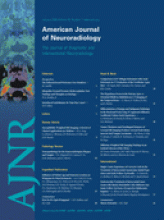Abstract
BACKGROUND AND PURPOSE: Wingspan is a self-expanding, microcatheter-delivered microstent specifically designed for the treatment of symptomatic intracranial atherosclerotic disease. Our aim was to discuss the effect of patient age and lesion location on in-stent restenosis (ISR) rates after percutaneous transluminal angioplasty and stenting (PTAS) with the Wingspan system.
MATERIALS AND METHODS: Clinical and angiographic follow-up results were recorded for all patients from 5 participating institutions. ISR was defined as >50% stenosis within or immediately adjacent (within 5 mm) to the implanted stent and >20% absolute luminal loss. For the present analysis, patients were stratified into younger (≤55 years) and older (>55 years) age groups.
RESULTS: ISR occurred at a rate of 45.2% (14/31) in the younger group and 24.2% (15/62) in the older group (odds ratio, 2.6; 95% confidence interval, 1.03–6.5). In the younger group, ISR occurred after treatment of 13/26 (50%) anterior circulation lesions versus only 1/5 (20%) posterior circulation lesions. In the older group, ISR occurred in 9/29 (31.0%) anterior circulation lesions and 6/33 (18.2%) posterior circulation lesions. In young patients, internal carotid artery lesions (10/17 treated, 58.8%), especially those involving the supraclinoid segment (8/9, 88.9%), were very prone to ISR. When patients of all ages were considered, supraclinoid segment lesions had much higher rates of both ISR (66.6% versus 24.4%) and symptomatic ISR (40% versus 3.9%) in comparison with all other locations.
CONCLUSION: Post-Wingspan ISR is more common in younger patients. This increased risk can be accounted for by a high prevalence of anterior circulation lesions in this population, specifically those affecting the supraclinoid segment, which are much more prone to ISR and symptomatic ISR than all other lesions.
- Copyright © American Society of Neuroradiology












